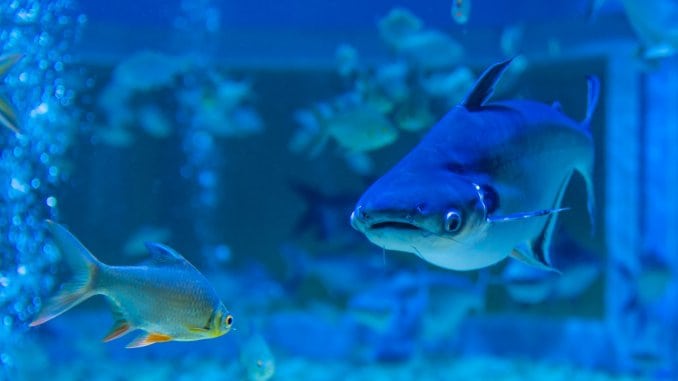
The word ‘shark’ on its own is enough to send chills down peoples’ spines. The fear for this large predatory fish is somewhat lost on the iridescent shark, just like the red tail sharks.
Iridescent sharks, also known as the siamese shark or sutchi catfish, are a species of catfish native to Southeast Asia and Thailand.
In the aquarium, they provide a lot of schooling activities. They are favored for their behavior and appearance.
If you are thinking about keeping this fish, you should read our complete care guide below to learn everything you need to know.
TABLE OF CONTENTS
Iridescent Shark Facts & Overview
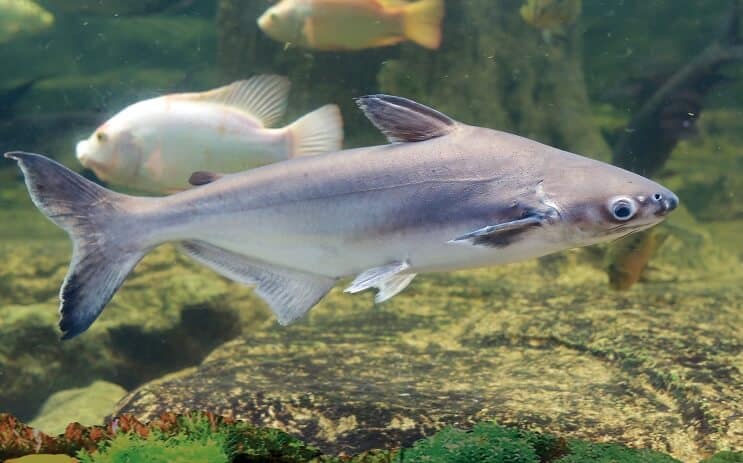
| Category | Rating |
| Care Level: | Advanced |
| Temperament: | Peaceful |
| Color Form: | Silver with darker dorsal side |
| Lifespan: | Up to 20 years |
| Size: | Up to 48 inches |
| Diet: | Omnivore |
| Family: | Pangasiidae |
| Minimum Tank Size: | 300 gallons |
| Tank Set-Up: | Pond or huge aquarium |
| Compatibility: | Other larger fish |
Scientifically they are known as Pangasianodon hypophthalmus, and they share a family with the Mekong Giant Catfish (one of the largest freshwater fish in the world).
As a mature adult the iridescent shark can grow up to four feet. Many people will buy them as small juveniles and not realize how big they can get.
The biggest challenge when keeping these fish is having the right size aquarium. While a 100 gallon for juveniles will be ok, 300 gallons will be needed as they begin to grow.
Their bright flashy colors have made them popular in the aquarium trade. They are hardy fish and eat a wide variety of food. Like most catfish or even goldfish, these sharks will eat anything they can find and as often as possible; this is what allows them to grow to such enormous sizes.
Typical Behavior
Iridescent sharks are fairly timid and can be easily scared. When this happens, they may hit their head on the glass or decor.
You can help keep them calm by placing the tank in a fairly quiet area, somewhere they aren’t likely to be scared by loud noises or people passing by the tank.
They are also likely to get harassed by more aggressive fish. Therefore, keeping them with large peaceful fish is important. There is an emphasis on large because any fish that can fit into the shark’s mouth will likely become food.
As juveniles, they school together and separate as adults. This schooling, combined with the flashing skin, is yet another reason why they were brought into the aquarium trade.
Appearance
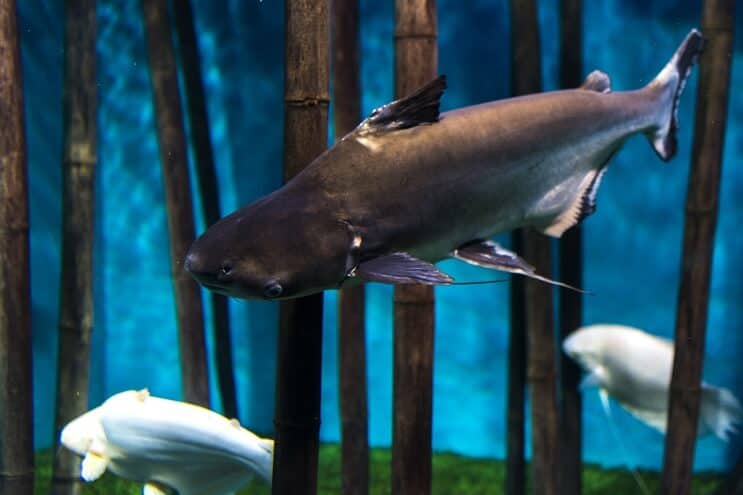
As the name states, these fish are iridescent. They have shiny skin on their sides as juveniles. They also have two black stripes on and below their lateral line. This line is a sensory organ that is filled with nervous tissue used to detect changes in the water.
Once they reach adulthood however they start to become uniformly gray. Another trait for adults you must have noticed by now is their size.
Females are usually larger and ‘plumper’ than males.
One unique thing about these fish is the fact they are “naked catfish”, meaning they do not have bony plates over their body. They do however have skin and choose to live in the middle of the water column.
They have long, whisker-like barbels, that help them to sense the environment.
There are a lot of sensory organs in fish like this and the reason stems from the water quality they are used to in the wild. Waters may be murky so they are not able to use their eyes all the time.
Habitat and Aquarium Setup
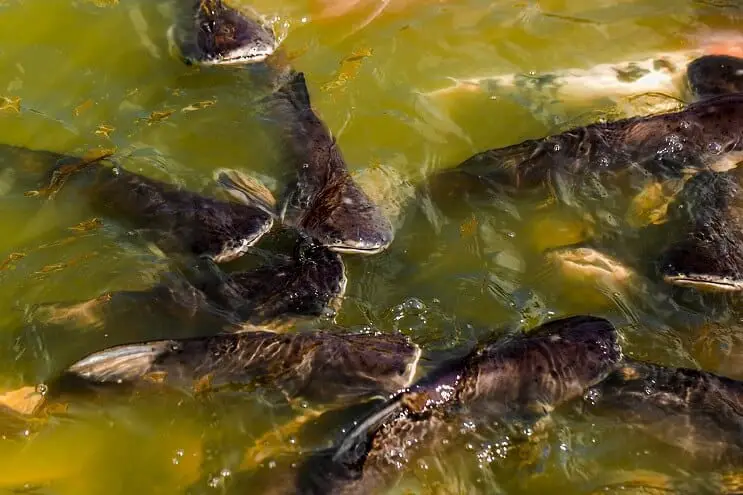
Native to Thailand, these fish thrive in deep rivers. These deep waters allow for large groups of adults to form. They stay in the middle of the water column and search for food.
They come from an incredibly diverse area (the Mekong River) which has direct effects on both fish and human populations.
The barbels on their head help them to search for food. This adaptation allows them to feel their way around in low visibility and water where a lot of sediment or low light is present.
Speaking of light, these fish are not like most catfish who are active at night; they are active during the day.
They are also migratory fish. During the rainy season, they swim upstream to spawn, only to return to lower waters to rear their young.
Tank Conditions
Using this information, a fish tank that is modeled on a river is best for these fish. This means having an open swimming space with rocks and driftwood around the floor of the tank.
The important part of the tank setup is the open middle water column. This is where your fish will spend most of their time and they will need a lot of room.
To keep these fish stress-free, make sure the water parameters do not fluctuate so much. As with most fish, they do not respond well to changes in these conditions even though they are hardy.
Iridescent Catfish require the following conditions:
- Temperature: 72-79°F
- pH: 6.5-7.5
- Hardness: 2-20 dGH
- Water Movement: Moderate
- Light Levels: Moderate
These fish have sensitive barbels so a soft substrate is needed. This will also replicate the river conditions they are used to in the wild, which usually have a soft muddy bed.
It is important to think about this fish’s large size and their nature. When they get scared, they can bash into equipment such as heaters and break them. To stop this, make sure you keep the tank in a quiet area of your home.
Also, consider hiding heaters where they cannot be broken, either using an external in-line or an under gravel heater.
You’ll need a powerful filter to help keep the tank water clean because these fish are very messy!
Plants can be eaten by these fish and should generally be avoided unless you’re happy for them to be eaten. If you choose to include plants, choose fast growing species such as hornwort and anacharis.
What Size Aquarium Do Iridescent Sharks Need?
A juvenile’s iridescent shark will need at least a 100-gallon aquarium. As adults, they will need a 300-gallon tank.
As juveniles, they will thrive within groups of around 4 or 5. This schooling will allow them to swim in the water column with less fear. After 300 gallons for the first fish, you should allow another 150 gallons for each iridescent shark that you add.
Tank Mates
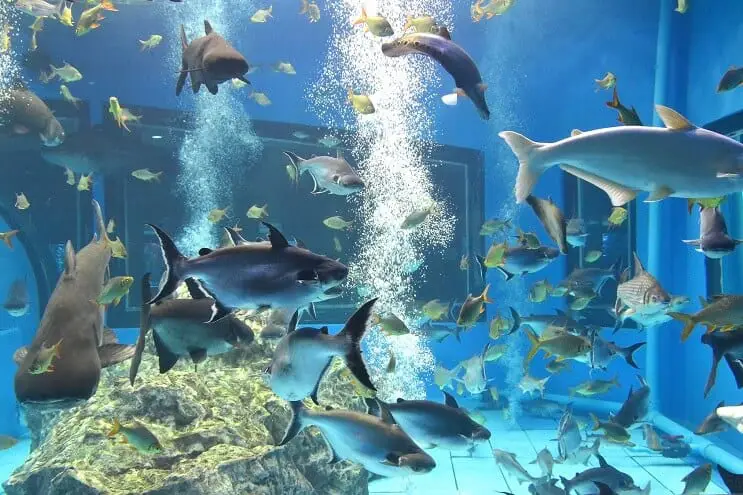
The biggest thing to remember when putting these fish with others is their size. Any fish that can fit in their mouth are likely to end up being enjoyed as a meal.
This means fish like Tetras, Danios, and Barbs are not good companions.
The good things are that these fish can be housed with lots of large peaceful fish such as:
- Plecostomus
- Synodontis catfish
- Pearsei
- Silver dollars
- Kissing gourami
- Leptobotia elongata loach
- Oscar
- Texas cichlid
- Salvin’s cichlid
- Bichir
- Fire eel
Any crustaceans will not do well with these fish and will likely end up being dinner.
As always, when adding more aggressive fish make sure to watch them interact. You never want to have your fish bullying one another.
If you ever have problems, then remove the aggressor from the tank. Most stores will take fish back for credit. This will keep your tank healthy as well as make sure you are not just wasting money trying new fish out.
Keeping Iridescent Sharks Together
Juveniles work best in groups and should be kept together. Having around 4 or 5 will make sure they thrive in your tank.
What To Feed Iridescent Sharks
The iridescent shark is an omnivore; they eat anything they can find.
As juveniles, they tend to eat more and more live and meaty foods however, as adults they tend to become more vegetarian and even lose their teeth. This behavior is also shared in other fish like the Pacu.
In the aquarium, this means your job is a bit easier. They require a balanced diet but will eat a variety of living, frozen, or pellet/flake foods.
To make sure their diet is balanced, feed your iridescent catfish high-quality flakes two or three times a day. Make sure to not overfeed them by only giving them enough food so that they eat it all within 5 or so minutes.
Then feed them live or frozen Bloodworms or Brine shrimp. Do this instead of the flakes every 2 or 3 days. This will help to give them the protein they need from a different source.
Another great supplement for these fish is live feeder fish, crickets, and worms. Live fish and other live foods are a great way to get nutrients to your fish as well as make feeding exciting and bring out their natural hunting behaviors.
If you decide to use feeder fish, buy them from your local store and quarantine them in a separate tank for a few days. This lets you check that all of them are healthy and won’t introduce diseases into your tank.
Care Guide
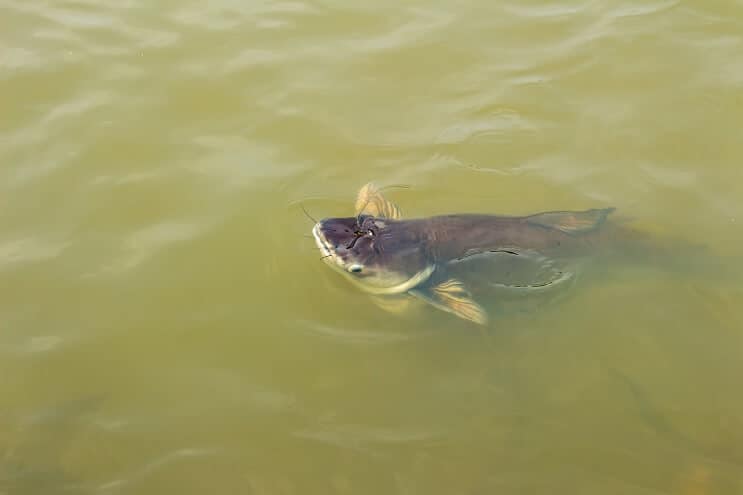
To make sure your fish are happy and healthy, the water needs to be as clean as possible. Iridescent catfish are messy by nature and need a strong filter.
You can help with the filtration by changing 25% of the water weekly. This is one of the most time-consuming duties of caring for your iridescent sharks. Understanding how much time you need to put in a tank is important. A tank like this will take more time due to the size, but it is well worth it.
When you carry out water changes, make sure you carry them out slowly so you don’t scare the fish and cause them to become stressed.
In terms of disease, these catfish are susceptible to skin fungus and ich. Being scale-less, it is harder to treat catfish with ich than most other fish. You will see white dots all over your fish and they will rub their sides on the tank.
Medications are available to help cure fungus and ich; many will state to use the dosage at half strength for scale-less fishes.
Always try to get to the root of the cause as well as medicating them – it’s quite possible that their water quality isn’t great if they’re getting diseases.
Breeding
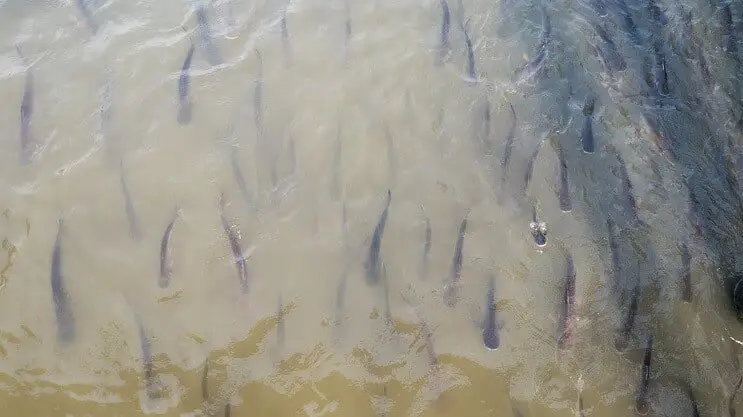
Because of their size and migrating behavior, these fish can not be bred in captivity. In the wild, they will travel upstream to breed during the late summer months when the water levels rise.
They breed in huge ponds in Southeast Asia. This allows for these huge adults to spawn without lacking the room they need.
The conditions needed in order to replicate the natural breeding season are nearly impossible to replicate in captivity.
Migration alone is one aspect that is vital to these fish and not possible in home aquariums.
Because they are so hard to breed in captivity it increases the importance of conserving their wild habitat. This is becoming a problem as pollution and human infrastructure continue to impact their natural habitat.
Are Iridescent Sharks Suitable for your Aquarium?
After reading this guide you should know the key care points about this fish; they are large and it will take a lot of time to keep their tanks clean.
Their size is what makes them truly hard to keep. Having a tank large enough to keep a fully-grown adult is something that only a few people can afford. Juveniles are smaller and will fit in smaller tanks; however, you still need to be ready for this growth.
They are truly hardy fish when it comes to water conditions and fit perfectly with other larger fish.
Feeding these fish is easy because they will eat anything that fits into their mouths; just keep it varied.
Have you kept this fish before? Let us know how large yours grew in the comments section below…

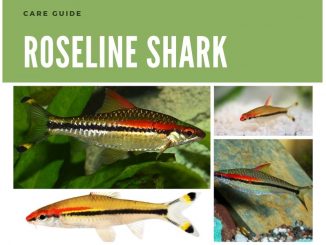
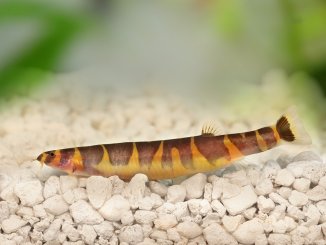
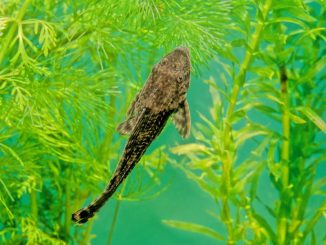
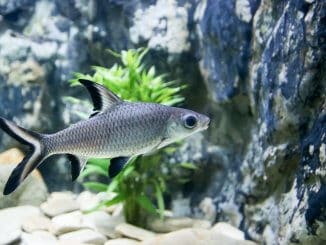
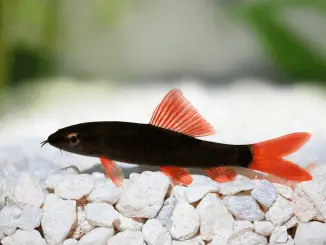
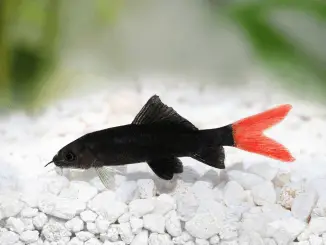
I’ve had 3 -4 sets of juvenile sharks, cool fish when they were small.. brought them @ Petco, PetSmart & other local pet stores in my area., UNTIL THEY GET BIGGER!! IF only I seen this information about 20 years ago!! I’ve had to replace 3 heaters, buy 2 more tanks { which in their frantic state by dashing around the tank} cracked my huge tanks! not to mention, eating EVERYTHING IN SIGHT!! These fish REQUIRE A 200 Gal.tank OR A POND TO KEEP THEM HAPPY & HEALTHY!! I hope this helps!!!
You’re right Allen, many people don’t realise how big these fish get when they first buy them. They need at least a 300 gallon tank or pond. Robert
Will 200gallon tank sufficient for 2 sharks?
I had three of them years ago in a 55 gallon tank, they lived for a good 8 years in the tank before they died and they got to be a good 17″ each before I lost them, but at that time I don’t know allot about them, I have some now in a 55 gallon but am in the process of looking for a larger tank but only thing I find funny is they talk about feeding them flake food but my sharks do not go to the top for food I have to get sinking pellets or they will not eat.
Same with my sharks they only eat the flakes if they have already sank to the bottom
Same with my shark, but I leaved the pellets there then the shark was eating on the top because maybe it is very hungry and it has to find any way for eating food.
Will a 50 litre tank be enough for iridescent sharks
What food they want to eat???? My IRIDESCENT SHARK HAVE CLOUDY EYES
Hello, I must say I enjoyed reading the article and comments. I bought an Iridescent Shark unknowingly from Walmart because my step-son wanted to add it to his 20 gallon tank (mainly Silver Dollar fish) I must admit, I knew and know little about fish and how to care for them (particularly back then, March of 2007). The shark grew to about 12-13 inches and is perfect in appearance. He is still alive and well at over the 12 year mark. Unfortunately, not knowing what he was, he had remained in a 20 gallon tank by himself for many, many years. Very spastic indeed, however always responded to my voice for direction, and to calm him down. He use to great me at any side of the tank when I called his name (Bubba), and mist of the time swam to the top to eat flakes twice a day while I placed some directly in his mouth. I found it incredible then, and more so now that I read the above! Tank conditions were always poor because cleaning the gravel stressed him out too much in that small environment. When they worsened during water testing, I see ked help and after describing my Bubba, I was informed of what he was and to look it up! In doing so, I realized how very wrong I had been these last 12 years and brought him in (gingerly, as if he were my baby) to a specialized aquarium store a few miles down the road. Ironically enough, someone else donated an iridescent shark earlier that day! The other much bigger (rounder) and having a bad spine and veryall poor shape. However, he is such a friendly shark (at least for me). I named him Root. So, thinking I may have stunted the growth of my Bubba, I now am deciding on buying a 75 gallon tank so I can bring him back home. They leave the bright light on (blue light seemed to be the most tolerable) I see he is extremely stressed by that. I just wish I knew for sure if he was no longer going to get bigger due to his stunted growth and out grow the 75 gallon tank. Sorry for the long story. Love to hear opinions on whether or not he will grow much more.
Hi Alan, thanks for sharing your experience. It’s great that you were able to find this out and return him to the store while you prepare his new tank, despite his age. It’s hard to tell whether he will grow any more. Given his age I would be tempted to say that he won’t, however he is very small so you might find that given a larger tank and the right conditions that he may very well grow slightly. Thanks, Robert
I have an iridescent shark that I purchased 32 years ago, he is now over 3 feet long and doing very well. He does however have a bump on his nose from running into his tank. He is now in a 300 gallon stock tank for cattle with a waterfall, he seems quite peaceful. I keep saying he but is there anyway to tell the sex of my fish his name is Fred, just wondered if I should change it.
Hi Virginia, females tend to be a be fatter than males, and are also slightly larger in color. Thanks, Robert
I just had a 400 gal indoor pond built for my 25 year old ID shark. I have been through multiple tanks, the latest being a 6’x2’x2 1/2’ one that I had custom made for him, but he seems truly happy in this pond. These fish are a huge life commitment.
My iridescent shark got its eyes filled with with some white cloudy type what exactly i dont know what is the problem i dont know please inform me whats the reason
Hi Million, the most likely cause is that the water conditions in your tank aren’t ideal. Have you performed checks on the ammonia, nitrites and nitrate levels? Thanks, Robert
Could you clarify what you mean by these fish are “messy”? We got 3 recently but we are rethinking our purchase after reading this :D
People think this fish is very rough and very aggressive
I bought a iridescent shark and the pet store people said the shark would only get 8 inches! So is there another type of iridescent or what?
I just bought one of these about a year ago. He is still only about 2 to 3 inches long in a 40 gallon tank. I’m upgrading to a 55 gallon this week. I’m so glad I found this article and comments. I had no idea what have. Thank goodness I already have a 300 gallon pond. When I bought him at one of the pet stores, PetSmart or Petco. Nobody knew what he was. There was no tag and he was the only one of his kind in the tank. Thank you for the information and am eager to take good care of my iridescent shark now that I know the proper way to care for him. Can’t wait to see him grow.
I had my id fish in a 100 gallon tank for 14yrs. He was with other fish like a pleco, some cichlids, and some clown loaches over the yrs. he was a fantastic fish and used to love rubbing against my fingers when I fed him. Yes at times he would dart across the tank and knock himself silly for while, while he sat at the bottom of the tank getting his bearings again. He grew to about 11” long and no larger. Now that he has just recently passed I am looking to get another one. When I purchased him I purchased 4 and it was a race track in there when they were little. My tank had an open top that I very quickly had to get a cover made for it because they would jump out of the water racing around. The 3 other only lived a few years but the one lived longer than any other fish I had. Over the yrs a few fish were introduced that just did t get along with him so I had to remove them. Like people they all have different personalities. One pleco I had didn’t seem to want to get along with any other fish and was very dominate chasing the other fish around. I have had 4 pleco s over the yrs and only one had a problem. Same with cichlids. Most were great but every so often one would become dominant so I would take that one back to the store. Over all I loved my id but they are a commitment due to their lifespan. I learned not to put too small of fish in the tank with him because they would disappear over the course of a few days so I always got medium sized fish to join him. I have a daughter on the way so this new id can grow with her over the yrs for her to enjoy as well.
Can I put Iridescent with black gost
As A tank mates
my ID shark is breathing its last now,its around 12inches ,i brought it in march 2013,it was good till evening but i dont know what has happened at its. lying upside down on tank floor,its so painful to see him that way.
I have one, I call him Lou. He is about 8in long, hes in a 29 gallon tank with a rainbow shark who is about 6in and a small pleco, they eat tropical flakes. When I got them at the pet store no one told me how big he would get and assured me my tank was big enough. He swims around ok and only gets a bit crazy with sudden bumps against the tank stand. I’m attached to him, as well as my other fish. So I really dont want to take him in or anything. The best I could do is a 125 gallon maybe. For now, he seems happy enough though :/
After learning much more about the one we have had in our 75 gallon, we decided to put ours in the koi pond. We converted our 14 ft deep in ground pool to a pond. There is plants, plecos, koi, goldfish, minnows, a baby red eared slider, and a wild bull frog.
We also have two geese and two pekin ducks that live in the pond yard and pond. We plan on gettin Jaws two more friends so she isnt by herself. I am hoping she will do good in there. We will be doing a ton of work in it this winter to make it even clearer and more self sustaining. Anybody have any advice to make her happiest in there? Will she get big enough to hurt my ducks or geese? Will my turtles be ok? Jaws is only about 8 inches long right now. My koi are about 10 inches, the turtles shell is about 6 inches long.
We have 2 ID sharks, one was bought from Walmart 24 years ago and the other we got from our lfs about 5 years ago when someone returned him due to his size. Both are around 3′ and even with the one being 24, they still chase each other for hours on end. We would not have chosen an ID shark if Walmart had said they would get to 3′ instead of telling us they would get to a max size of 12″, but we also should have done more research. The older one was in a 45 gallon aquarium with my wife’s mother for 15 years. When he came to our house, we got a 125 gallon aquarium and he quickly doubled in size. About 2 years later we got the second one and a 300 gallon stock tank and both grew to about 2′. We moved to a new house so I built a 700 gallon, simple wood box with a pond liner and over the last year and a half, they have grown another 1′. They are moving to a 3000 gallon pond in our back yard next month, so we will see if the 4′ estimations I’ve read about are accurate.
I have an iridescent shark in my 20 Gal tank. I had no idea he would get so big! I noticed he has started growing quickly and started researching ID sharks to find out if he would surpass the 6” the fish store told me he would grow!
I don’t know what to do now. I have since moved from Florida to Pennsylvania, and have not found a fish store that will buy back a fish.
This article also explains his erratic behavior in the tank, always dashing around and hiding in the corner.
I didn’t realize I was giving him such a poor life, I originally bought him for my kindergarten class, because they wanted a shark in the tank, so I got an ID shark and a few other species I am now going to look up to see if they also need to be rehomed.
Any ideas on how I can rehome my poor fish?
Hello, My Shark fish is now 12 years old, previously they used to stay calm, but in recent period of time I see them little bit afraid, I read your above article, where you have mentioned that the tank should be placed at a calm place, but truly speaking from last 12 years the tank is in my hall and they have never reacted like this… suddenly there is a change in their behavior. even they have stopped eating as I used to feed them twice a day.
Kindly help…
I have a iridescent shark it’s 14 years old and been in many tanks. We have him in a tank now 300gals he is 20 inches long. Tank as 2 pumps one on each end. Got a another tank order for him 8×31/2 x 30 inches high.. right now he isn’t eating was wondering what is causing this.. we clean out the rocks with a small pump that sucks up the waste and food it sometimes scares him.. we replace the water that we take out .. there’s a alge eating in the tank with him fir as long as him.. this shark only eats wafer food he is a vegetarian wouldn’t eat live feeder fish or blood worms or shrimp.. what can I do to get him to eat.. advice please worried
Susan
My first two of these iridescent sharks grew up to 2feet in a 120 gallon tank I eventually gave them to a friend who had a pond. Now 35 years later getting back into the aquarium Hobby they were of course one of the fish that I first wanted to get and I did so got two of them one of them immediately vanished I knew they were jumpers I look everywhere for it but could not locate it inside the tank or outside. The one I have left is in a 55 gallon tank he does the same as my first two 35 years ago they would always go to the top of the water taking air and then see them blowing bubbles out of their mouth they did this all the time mine always came to the top of the tank when it was feeding time and then as the food got eaten they would then go to the bottom of the tank to scour the gravel for more. Now with this little guy I have i have definitely noticed with this one and I have I can clearly see that this one is extremely lonely when he had his buddy with him they were always out swimming around as was the case for the ones I had 35 years ago but this little guy sometimes I think he’s died and and won’t even come out of hiding for food but here in the past week when I feed the tank it takes a second or two but then he will shoot out of the dark go straight to the top of the tank and start eating I’m very pleased to see that but after all that’s done he goes right back into hiding I know he’s lonely. the other fish are not aggressive I have tried all the local fish stores here in town none carry it or have never heard of it I’ve even taken pictures of it in to show them what I’m looking for. There’s only one place here in town that carries them it’s a fish farm but you can’t go there in person to make a purchase you have to order them online and they will deliver them in the mail my first two made the trip successfully cost me $50 for shipping I pay for all the precautions that are necessary to make sure they had a safe journey and that also gives me a guarantee of alive on arrival . But the second time around when I made a purchase of two more for this lonely one I did the same $50 shipping make sure the Box had Styrofoam insulation and an ice pack, where I live the temperature guess close to 115 degrees I had ordered several fish all of them survived but the two iridescent sharks sadly I’m very disappointed did not make it now of course I paid the $50 shipping because with that I also get a live on arrival guarantee and if they don’t make the trip I have a lifetime guarantee that I can replace them. So right now I’m waiting for cooler weather cuz I do believe that the hotter weather was the major factor of their demise, so I keep telling this little one hang in there I’ll get you to Buddy soon as the weather cools if Alto he can understand anything I’m saying to him but the thought is there. Also I went to Wikipedia got some information about them and sadly I discovered like with a lot of animals on this planet the iridescent shark is an endangered species I was very surprised to see that according to the graph it stays anywhere from extinct 2 non concerning they are right in the middle an endangered species. I wish all of you luck in the rear your iridescent, give me even though they are endangered I’m hoping my little one will hang in there until I can get a few more buddies for him and that will be the last time I by these fish to put them in a fish tank with their life span is considerably shorter than it would be in their natural habitat
I have a 19yr old Irredesant Shark. He’s about 12 in long and very healthy! It was my son’s 1st Birthday and I promised him a fish for his birthday. I took him to Meijer and bought him the Irredesant Shark. And he loved that fish. He named him Sharky. I didn’t know anything about a Irredesant Shark when I purchased him. So I put him in a 10gal tank. He did just fine. I kept his water and tank clean. I couldn’t put any other fish in the tank with him though. He’s very territorial! Not even a Alge Eater. He would attack and bite every fish I tried to put with him. Sadly by keeping him in 10gal tank for those years it stunted his growth. But like I said I had no idea that he could grow to be that big. I didn’t know anything about that kind of fish at all. I know a lot about them now. He’s now in a 55gal tank by himself like he likes and doing excellent. He’s 19yrs old and my son is now turning 20yrs old. He grew up with that fish.
We have two and we have had them for over 20 years niw they are at least 3 1/2 to 4 feet in length. We have them in a 3000 gallon pond in our back yard. They are very hardy fish that’s for sure. They also interact with us. It’s amazing how sweet they are When I bought the first one it was from Walmart and said it would not grow more than 2inches boy did they lie. Although she got really big I never got rid of her we moved houses just to make a better area for them to have. They are part of our family and we wanted to be sure to do the best that we could for them.